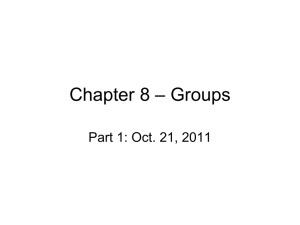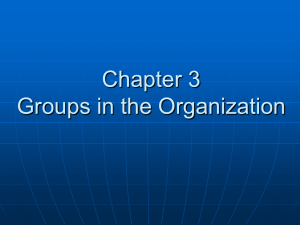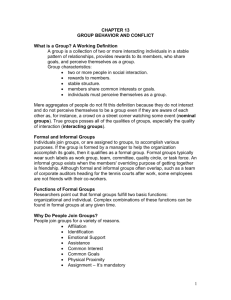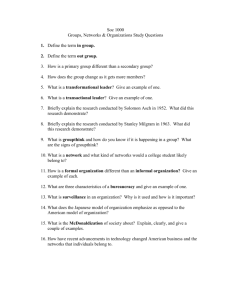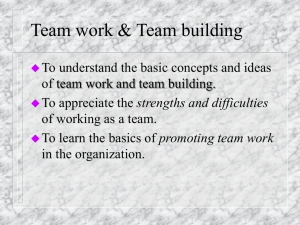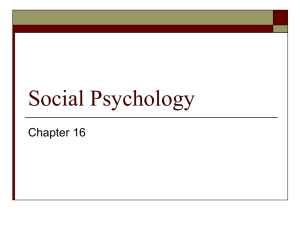Group Processes - Gordon State College
advertisement
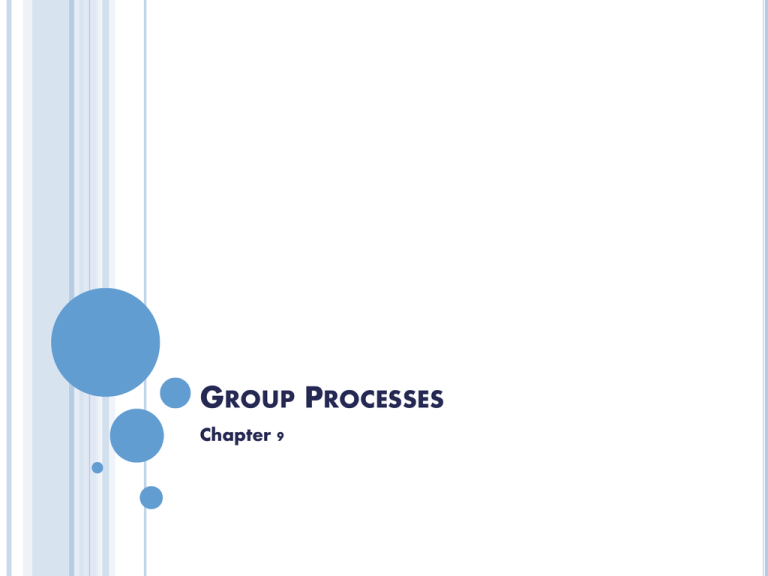
GROUP PROCESSES Chapter 9 GROUP Two or more people who interact and are interdependent in that their needs and goals cause them to influence each other. GROUPS Groups are a source of identity. Groups give us social knowledge and clarify ambiguity. Groups establish some social norms. CHARACTERISTICS OF GROUPS Most groups have 2-6 members (Group members interact.) Group members are similar to each other Groups create their own social norms Social roles are shared expectations in the group about how particular people should behave Individual identities and personalities can get lost (Zimbardo Prison Experiment) GENDER ROLES All societies have expectations about how people will behave based on their gender. These vary by culture, but universally people identify nurturing, as female and as male. Changing gender roles causes conflict and creates role strain and ambiguity and sometimes role conflict. This has happened in the United States as women’s appropriate roles have come to be perceived as more like men’s. GROUP COHESIVENESS The qualities that bind group members together, foster group loyalty, and contribute to interpersonal liking. Members of more cohesive groups tend to stay in the group, to be active participants, and to recruit new members. SOCIAL FACILITATION: PRESENCE OF OTHERS People tend to do better on simple tasks when in the presence of others, but they tend to do worse on complex tasks if their individual performance can be evaluated. The same is true of cockroaches. In general, the presence of others causes physiological arousal and affects our behavior in a variety of way. SOCIAL FACILITATION: PRESENCE OF OTHERS Explanations for this phenomenon include: 1. Others cause us to become alert and vigilant. 2. Others make us apprehensive about how we are being evaluated. 3. Others distract us from the task at hand. SOCIAL LOAFING When we can merge into the group and become less identifiable or noticed, we feel more relaxed. This has the opposite results of social facilitation. If people cannot be identified, they do worse on simple tasks and better on complex tasks. The tendency to loaf is stronger in Western than Asian cultures. DEINDIVIDUATION: GETTING LOST IN THE CROWD This loosens normal constraints and permits an increase in impulsive and deviant behaviors. This phenomenon partially explains mobs, lootings, lynching's, etc. People feel less accountable since it would be hard to single them out for blame. It increases the extent to which people obey group norms (not always aggressive or antisocial). GROUP DECISION MAKING Groups can make decisions as good as those of individuals They do well if they listed to the most expert member. Groups are usually used to make important decisions. Some factors cause groups to make worse decisions GROUP DECISION MAKING Groups tend to focus only on shared information and to ignore that possessed by some members. To counteract this: Hold longer discussions Assign specific group members to develop expertise in one or more aspects of the issue and to then share this with the group. GROUPTHINK Groupthink occurs when the group seizes an initial solution and supports it rather than considering other possible alternative. It is most likely to happen in highly cohesive groups whose leaders let their preferred courses of action be known. The focus of the group then comes to be pleasing the leader and maintaining group cohesiveness rather than finding the best solution to the problem. GROUPTHINK In order to avoid groupthink: The leader should remain impartial Effort should be make to seek outside opinions Subgroups for discussion/research can be created Members can be allowed to express their opinions anonymously. Brainstorming techniques can be used. GROUP POLARIZATION/RISKY SHIFT Groups tend to make decisions that are more extreme and/or involve more risks than their members individually. One explanation is that members give each other new arguments toward the same goal/position. Another explanation is that members gain confidence in their direction when they realize that others feel the same way. LEADERSHIP The Great Person Theory of Leadership says that certain personality types will make good leaders in any situation. The correlational evidence is weak, but leaders tend to be slightly more: Intelligent, confident, charismatic, extroverted Driven by the desire for power Open to new experience Stable – Lacking in nervousness Socially skilled LEADERSHIP STYLE THEORY Transactional Leaders set clear, short-term goals and reward those who reach them. Transformational Leaders inspire their followers to focus on long-term goals. CONTINGENCY THEORY OF LEADERSHIP Task-oriented leaders are more concerned with getting the job done. Workers feelings and relationships are secondary. Relationship-oriented leaders are more concerned with workers feelings and relationships. CONTINGENCY THEORY OF LEADERSHIP A comprehensive leadership theory should focus on followers and the situation as well as the leader. Specific leaders may be successful in one situation but not another. More specifically, the success of the leadership depends upon the leader type and the amount of control or influence he or she has in the situation. CONTINGENCY THEORY OF LEADER Task-oriented leaders are most effective in: High-control work situations where relationships with subordinates are very good and work is very well-defined. Low-control work situations where leadersubordinate relationships are not very good and the work is poorly defined. CONTINGENCY THEORY OF LEADERSHIP Relationship-oriented Leaders are most effective in: Moderate-control situations where: Things are going fairly smoothly Some work/attention is needed because of poor relationships SOCIAL DILEMMAS Two people, groups, organizations, or even nations have incompatible goals which place them in conflict. A social dilemma is a situation where the most beneficial action for an individual will have harmful effects on others. In the Prisoner’s dilemma game, rewards are set on a contingency plan such that if both parties choose cooperatively, the payoff is highest for both. If both choose selfishly, both get the lowest payoff. However, if only one cooperates, he/she gets the lowest payoff, and the other gets the highest possible payoff. PRISONER’S DILEMMA GAME The dynamics of the game are such that in order to choose cooperatively, one hopes that the other will do likewise. In short, you must trust your partner. How do we foster a cooperative strategy? Allow friends to play. Allow individuals, not groups, to play. Let them expect future interaction with the other player. Foster a cooperative norm (the Community Game). Use a tit-for-tat strategy. Always respond the way the other player did on the previous turn.
